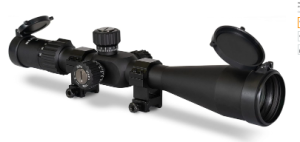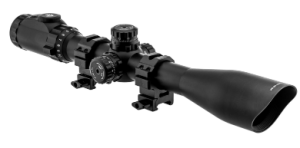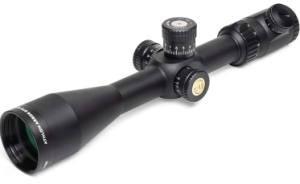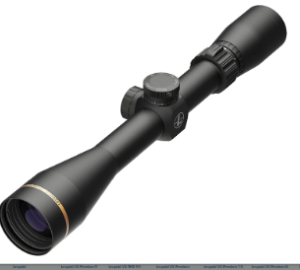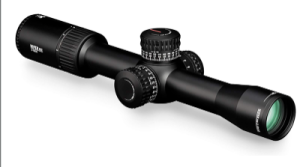The Vortex Viper PST Gen II 2-10×32 FFP. Designed for shooters who demand tactical precision across a wide range of distances, this scope is an outstanding option for those using hard-hitting .357, .45, or .50 caliber airguns.
At the core of this scope’s appeal is its First Focal Plane (FFP) reticle, which ensures that holdovers, wind corrections, and range estimations remain accurate throughout the magnification range. From close-quarters shooting at 2x to precision targeting at 10x, the PST Gen II remains crisp and responsive, making it an ideal optic for both short and extended-range scenarios.
The laser-etched turrets, RZR Zero Stop, and adjustable parallax give you full control when dialing for elevation and windage corrections—perfect for airgunners who want to push their rifles to 100 yards and beyond. The fiber optic rotation indicator is a welcome touch, allowing you to track turret movement at a glance, preventing accidental over-rotation during field use.
Optically, this scope stands out with extra-low dispersion glass for excellent resolution and true-to-life color, while XR fully multi-coated lenses maximize light transmission. The Armortek coating protects your lenses from scratches, dirt, and oil—essential for rough hunting environments.
Housed in a single-piece aircraft-grade aluminum tube, the Viper PST Gen II is argon purged and O-ring sealed for fogproof and waterproof reliability, ensuring it stands up to the demands of any big bore airgun setup.
Specifications:
-
Magnification: 2x – 10x
-
Objective Lens Diameter: 32mm
-
Reticle: First Focal Plane (FFP), illuminated
-
Turrets: Laser-etched, tactical style with RZR Zero Stop
-
Parallax Adjustment: Side focus
-
Reticle Illumination: 10 brightness settings with off positions between
-
Glass Type: Extra-low dispersion (XD) glass
-
Lens Coating: XR fully multi-coated + Armortek protective coating
-
Tube Size: 30mm
-
Construction: Aircraft-grade aluminum, single-piece tube
-
Sealing: Argon purged, O-ring sealed (fogproof & waterproof)
-
Length: ~12.75 inches
-
Weight: Approx. 26 oz
Pros:
-
True FFP Reticle: Holdovers remain accurate at all magnification levels
-
Premium Glass Clarity: XD glass and XR coatings enhance brightness and color fidelity
-
Zero Stop Turrets: Easy and reliable return to zero
-
Illuminated Reticle: 10 brightness settings for all light conditions
-
Rugged Build: Durable and weatherproof—perfect for demanding airgun use
-
Compact and Versatile: Ideal balance of size and performance for air rifles
-
Protected Lenses: Armortek coating resists scratches, oil, and dirt
Cons:
Also read;5 Best Big Bore Air Rifle with Longest Effective Range
Factors to Consider When Choosing Best Scope for Big Bore Air Rifle
1. Recoil Durability
Big bore air rifles produce significantly more recoil than standard airguns—often comparable to that of powder-burning firearms. As a result, your scope must be shockproof and recoil-rated to withstand this force. Many scopes not designed for airguns will lose zero, shift internally, or even break under the pressure. Look for scopes built on reinforced platforms (like UTG’s True Strength or aircraft-grade aluminum tubes) that are specifically tested for heavy recoil resistance.
2. Reticle Type and Focal Plane
The reticle design plays a major role in how quickly and accurately you can acquire and hold on a target. Duplex reticles are great for quick target acquisition, while Mil-Dot or MOA-based reticles allow for more precise range estimation and holdover. Additionally, scopes come with either First Focal Plane (FFP) or Second Focal Plane (SFP) reticles. FFP reticles scale with magnification, keeping holdovers accurate at any zoom level—ideal for long-range shooting. SFP reticles remain the same size, which can be simpler for beginners but require calculations at specific magnifications.
3. Magnification Range
The right magnification range depends on how you plan to use your big bore air rifle. For general hunting and medium-range target shooting, a 3-9x or 4-16x scope offers great versatility. If you’re aiming to stretch your air rifle’s range (100–200+ yards), consider higher magnification scopes like 6-24x. However, too much magnification can reduce your field of view and light transmission—so balance is key.
4. Optical Clarity and Coatings
Big bore air rifles often get used for hunting or precision shooting, where clarity and light transmission are critical. Fully multi-coated lenses, especially with coatings like Leupold’s Advanced Optical System or Monstrum’s emerald coating, enhance brightness, contrast, and clarity. These coatings also reduce glare and reflection, ensuring a clearer sight picture in dawn, dusk, or bright sunlight—vital for quick, ethical shot placement.
5. Durability and Weatherproofing
Since big bore air rifles are frequently used outdoors—whether for pest control, hunting, or competition—your scope must be able to withstand the elements. Look for scopes that are waterproof, fogproof, and nitrogen- or argon-purged to prevent internal fogging. A scope with scratch-resistant lenses and a tough exterior finish (such as matte anodizing) is also better suited for rough terrain and inclement weather.
6. Parallax Adjustment
Big bore air rifles are commonly used at a wide range of distances—from close-range hunting to long-range target practice. Scopes with Adjustable Objective (AO) or Side Focus parallax adjustment allow you to fine-tune focus and eliminate parallax error at various distances. This is especially important when shooting at targets under 50 yards or beyond 100 yards, where parallax issues are more pronounced.
7. Turret Precision and Zero Retention
Precision shooting with a big bore air rifle demands reliable, repeatable turret adjustments. Scopes with tactical turrets, zero-resettable and zero-locking features are excellent for making fast elevation and windage changes, especially for long-range shooting. Look for audible and tactile clicks (usually ¼ MOA or 0.1 MRAD) that allow you to confidently dial in corrections without second-guessing your adjustments.
8. Illumination and Low-Light Performance
Many hunting scenarios or field conditions occur in low light—at dawn, dusk, or in shaded forest environments. A scope with an illuminated reticle, preferably with adjustable brightness and color settings, allows for better visibility of your aiming point. Multi-color systems (like UTG’s 36-color IE system) or dual-red/green reticles help shooters maintain accuracy regardless of background lighting or contrast.
